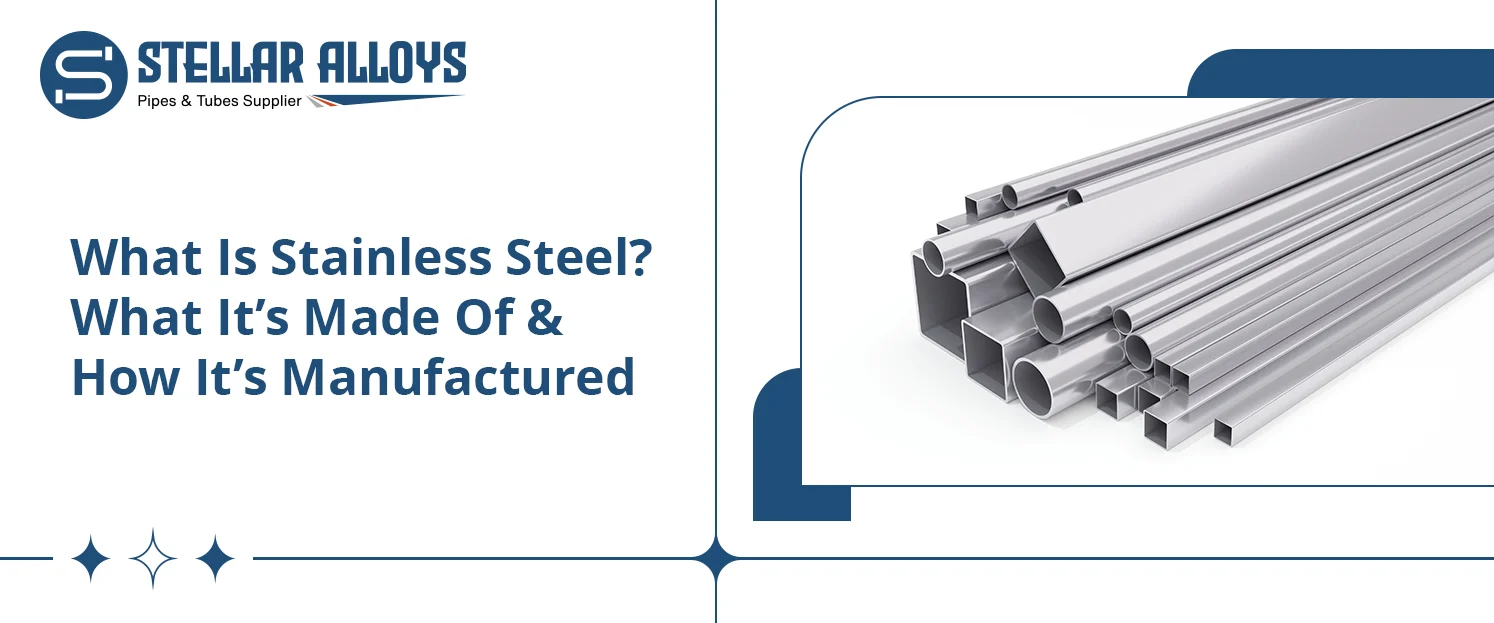What Is Stainless Steel? What It’s Made Of & How It’s Manufactured

Stainless steel (SS) is a corrosion-resistant alloy primarily composed of iron, chromium and other elements such as nickel, molybdenum, or manganese. With at least 10.5% chromium, it forms a protective oxide layer that prevents rust and degradation, even under challenging environmental conditions.
What sets stainless steel apart is its unique combination of strength, hygiene, recyclability, and versatile finishes, making it a preferred material across industries. Since its invention in the early 20th century, stainless steel has become an essential material used in everything from surgical instruments and skyscrapers to industrial machinery and electrical enclosures. In India, stainless steel manufacturing has advanced significantly, ensuring consistent quality, affordability and accessibility for both domestic and international markets.
In this blog, you will learn what stainless steel is made of, how it is manufactured, the main types available and its key applications across various industries providing a complete overview of this vital material.
What Is Stainless Steel Made Of?
Stainless steel is an alloy made of iron, chromium, nickel, and other elements that enhance its strength, durability, and corrosion resistance. Chromium (10.5%–26%) forms a protective oxide layer to prevent rust, while nickel (8%–20%) improves ductility and toughness. Molybdenum (2%–3%) increases resistance to pitting corrosion, and carbon (<0.1%–1.2%) adds hardness. Small amounts of manganese, silicon, nitrogen, titanium, and niobium further strengthen the steel, improve oxidation and corrosion resistance, and enhance machinability, making stainless steel versatile for applications across construction, food processing, aerospace and medical industries.
How Stainless Steel Is Made? Manufacturing Process
The production of stainless steel begins with gathering the necessary raw materials, which are then processed through several key steps to achieve the final alloy with desired properties.
Step 1: Melting
The raw materials, including iron, chromium, nickel, and other alloying elements, are heated in a furnace most commonly an electric arc furnace until fully molten. This stage ensures all components are blended uniformly.
Step 2: Carbon Adjustment
Excess carbon is removed using vacuum oxygen decarburization (VOD) or argon oxygen decarburization (AOD) processes. The carbon content determines the final grade such as standard or low-carbon variants (e.g., 304 vs. 304L), affecting strength and hardness.
Step 3: Stirring and Alloy Refinement
The molten steel may be stirred to distribute alloying elements evenly and remove impurities, ensuring uniform quality that meets industry specifications.
Step 4: Forming
While still hot, the steel undergoes hot rolling to shape it into billets, blooms, or slabs. For precise dimensions, cold rolling may follow, producing flat sheets or strips suitable for further processing.
Step 5: Heat Treatment/Annealing
To relieve internal stresses and enhance mechanical properties, the steel is annealed, heated and cooled under controlled conditions. Post-annealing, the surface may be descaled to protect the oxide layer that ensures corrosion resistance.
Step 6: Cutting and Shaping
The steel is then cut and shaped to meet specific application requirements. Thick plates may be mechanically sheared, while thinner sheets are often cut using CNC machines or laser cutters for precision.
Step 7: Surface Finishing
Finally, stainless steel may undergo surface finishing, such as grinding or polishing, to remove imperfections, improve appearance and enhance corrosion resistance before being shipped to manufacturers.
This systematic process ensures that stainless steel meets strict standards for strength, durability and corrosion resistance making it suitable for industries ranging from construction and automotive to medical and food processing.
Types of Stainless Steel
Stainless steel is categorized based on its microstructure and alloying elements. Here are the types of stainless steel listed below:
Austenitic Stainless Steel
The most widely used type, containing 16 – 26% chromium and 8 – 20% nickel with low carbon. Non-magnetic and highly corrosion-resistant, it offers excellent toughness, ductility, formability, and weldability, though it may be prone to stress corrosion in chloride environments.
Ferritic Stainless Steel
Contains 11 – 18% chromium with little or no nickel and low carbon. Magnetic and moderately corrosion-resistant, ferritic steels have good thermal conductivity and high-temperature oxidation resistance but lower toughness and limited weldability.
Martensitic Stainless Steel
With 11 – 18% chromium and higher carbon (0.1 – 1%), martensitic steels are magnetic and can be hardened by heat treatment. They provide high strength and hardness making them ideal for knives and wear-resistant applications.
Duplex Stainless Steel
Combines roughly 50% austenite and 50% ferrite with 18 – 28% chromium, 4 – 8% nickel, 2.5 – 4% molybdenum, and 0.1 – 0.3% nitrogen. Duplex steels offer high strength, excellent corrosion resistance and improved resistance to stress corrosion cracking.
Applications of Stainless Steel
Stainless steel is widely used across industries due to its strength, corrosion resistance and low maintenance making it a versatile material for a variety of environments and applications.
Construction and Architecture: Stainless steel is increasingly used in modern construction for its durability, weather resistance and sleek appearance. It is commonly found in roofing, cladding, staircases, railings, structural panels, and support elements, especially in urban infrastructure, smart buildings and prefabricated structures.
Kitchenware and Appliances: Its hygienic surface, heat resistance, and durability make stainless steel the preferred choice for kitchens. Cookware, sinks, ovens, refrigerators, and countertops are often made from SS 304 and SS 316 with SS 304 being particularly popular for handling heat, moisture, and frequent cleaning without corroding.
Automotive and Aerospace: Stainless steel is essential in applications where strength, heat resistance, and weight efficiency are critical. Grades like 409, 430 and 304 are used for exhaust systems, chassis components, fuel tanks and structural supports. In aerospace, stainless steel is used in high-temperature parts, safety components and structural elements due to its stability and performance under extreme conditions.
Industrial Machinery: Stainless steel components are vital in machinery that must endure pressure, vibration, and corrosive environments. Applications include fasteners, valves, bearings, housings, and heat exchangers. Stainless steel rods, bars, and bright bars are widely employed across manufacturing plants, refineries and equipment fabrication.
Medical and Surgical Instruments: The biocompatibility and corrosion resistance of stainless steel make it ideal for surgical tools, implants, trays, needles, and orthopedic pins. Grades like SS 316 are preferred for their ability to withstand repeated sterilization and maintain a non-reactive surface making them indispensable in hospitals and laboratories.
Conclusion
Stainless steel continues to be a critical material across industries offering unmatched corrosion resistance, strength, and versatility. Understanding its composition, manufacturing process and types helps professionals choose the right grade for applications ranging from construction and automotive to medical and aerospace.
At Stellar Alloys, we provide high-quality stainless steel products tailored for your specific needs. Explore our range of stainless steel pipes, tubes, and sheets to ensure durability, performance, and efficiency in your projects. Make your next industrial or architectural project stand out with reliable stainless steel solutions.
ABOUT US
Progressively maintain extensive infomediaries via extensible nich. Capitalize on low hanging fruit. a ballpark value added is activity to beta test. Override the digital divide with additional click throughs from fruit.
LOCATIONS

